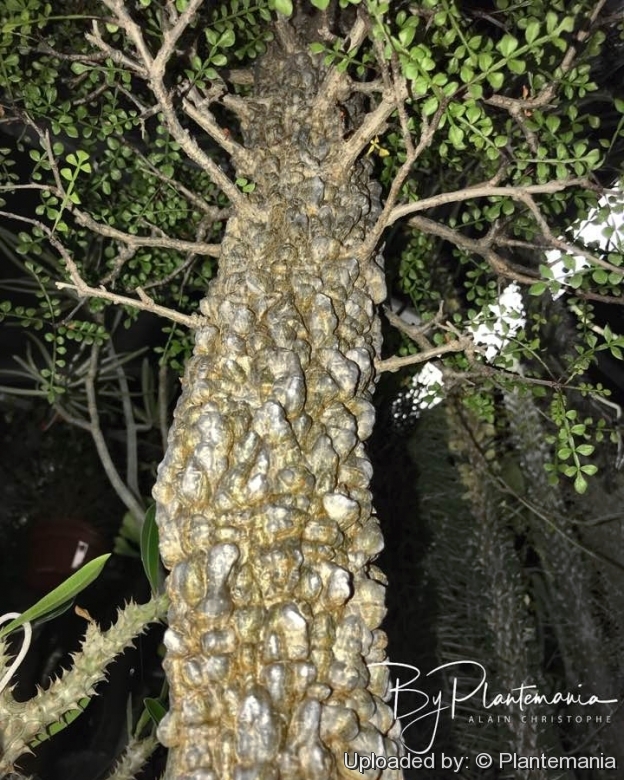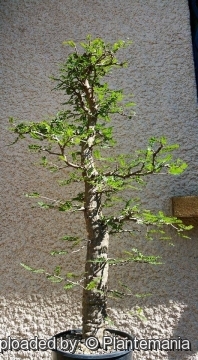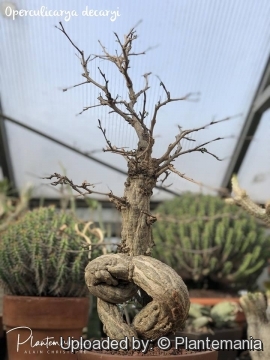




Your support is critical to our success.

Origin and Habitat: Operculicarya decaryiSN|29905]]SN|29905]] is endemic to S and SW Madagascar, where it grows in the provinces of Toliara and Fianarantsoa. It is a wide raging and relatively common species (Estimated area of occupancy km2: 351). There are 37 known subpopulations.
Altitude range: 0-999 metres above sea level.
*Habitat and Ecology: This shrub or tree grows in xerophyte thickets and forests. Even though there is continuing decline, this affects only part of its range. Over-harvesting seedlings from O. decaryi is a substantial threat to reproductive success in the species. During the dry season in the south, the bark and cambium of Operculicarya decaryiSN|29905]]SN|29905]] constitutes an important component in the animals' diet. This contains a high percentage by weight of water, and may be critical to the animals' survival in the arid season.
Synonyms:
- Operculicarya decaryi H.Perrier
FRENCH (Français): Faux-poivrier du Japon
Description: The Jabily or "elephant tree" (Operculicarya decaryiSN|29905]]SN|29905]]) is a natural succulent bonsai tree or shrub from Madagscar with thickened roots. It is a very slow growing, deciduous, dioecious pachycaul, looking somewhat like a dwarf baobab, rarely exceeding 5 metres tall, but sometimes taller (up to 15 meters in very old spectacular specimen trees?). It has small (less than 2 mm) red flowers in winter. The inflorescence is at the end of short branches and often consist of about five flowers.
Derivation of specific name: This species is named after the collector Raymond Decary.
Stem: Trunk, parallel-sided, bottle-shaped, , barrel-shaped, globular or conical, 1-6 m tall 30-100 cm in diameter, bark irregularly tuberculate (warty-bumpy), fissured dark grey. Branches umbrella-like, thin, spreading, zigzag. Twigs glabrous or hairy and glabrescent, straight. Young plants of Operculicarya decaryiSN|29905]]SN|29905]] have a round, football-like caudex and are very attractive.
Roots: Thick, fleshy water-storing.
Leaves: Paripinnate 2.5-6 cm long, with (4-)5-7(-9) pairs of leaflets, glabrous or with scattered hairs, rachis often conspicuously winged. Leaflets circular to ovate, 4-7 x 3-4 mm, not touching each other, tip rounded, upper face dark green and glossy, lower face paler, with 3-4 pairs of veins.
Flowers: Unisexual, inconspicuous, dark red. The pedicels are articulated and have multicellular glandular hairs, which also occur on the bracts, bracteoles and perianth.
Fruits: Stalked. The fruit is a typical drupe, 5-6 mm long, globose to drop-shaped containing a mostly unilocular, woody stone (hard seed) which is operculate (having an operculum, a small covering or lid).
Bibliography: Major references and further lectures
1) Members of the IUCN SSC Madagascar Plant Specialist Group. 2015. Operculicarya decaryi. The IUCN Red List of Threatened Species 2015: e.T68002446A68019576. http://dx.doi.org/10.2305/IUCN.UK.2015-4.RLTS.T68002446A68019576.en. Downloaded on 17 January 2017.
2) Randrianasolo, A. and Lowry II, P.P. 2003. “Operculicarya (Anacardiaceae) revisited: an updated taxonomic treatment for Madagascar and the Comoro Islands, with descriptions of two new species”. Adansonia 28: 359-371.
3) Urs Eggli “Illustrated Handbook of Succulent Plants: Dicotyledons” Springer Science & Business Media, 2002
4) Werner Rauh, Herman Schwartz “Succulent and xerophytic plants of Madagascar”, Volume 2 Strawberry Press, 1998
5) Wikipedia contributors. "Jabily." Wikipedia, The Free Encyclopedia. Wikipedia, The Free Encyclopedia, 30 Dec. 2014. Web. 30 Dec. 2014.
6) TopTropicals.com Operculicarya decaryi http://toptropicals.com/catalog/uid/Operculicarya_decaryi.htm
7) Caroline Harcourt, Jane Thornback “Lemurs of Madagascar and the Comoros: The IUCN Red Data Book” IUCN, 1990
8) Von-Teichman, I.; Hardy, D. S., 1992: “Flower and fruit structure of operculicarya decaryi h. perrier anacardiaceae from madagascar”. Botanical Bulletin of Academia Sinica (Taipei) 33(3): 225-232

Operculicarya decaryi Photo by: © Plantemania

Operculicarya decaryi Photo by: © Plantemania
Cultivation and Propagation: Operculicarya decaryiSN|29905]]SN|29905]] is fairly easy to grow both indoors, as well as outdoors. In the winters it is deciduous, except in very tropical areas. It cannot tolerate freezing conditions. Propagation from seed is very slow and modest-sized plants require several years growth.
Growth rate: It is a fairly slow growing plant.
Soil: It prefer a porous gritty or sandy soil with at least 50% inorganics, and requires excellent drainage.
Fertilization: Fertilize regularly for good growth and health.
Repoting: Repot the plant every 3 years; this is quite tricky given the spines.
Waterings: It needs regular water when the plant has leaves since it is a tree, contrary to popular belief, it likes a lot of water in the warm summers, as long as it's planted in a very well draining soil. Indoors it is best to keep on the dry side, or it is prone to rot. During the winter they may go dormant, so water less during this period.
Exposures: It like full sun to light shade with warm temperatures.
Temperatures: Temperature from spring to autumn: nocturnal 15°C or more and diurnal 25-45°C. Wintering: nocturnal 10°C or more and diurnal 18°C or more.
Cultural Practices: Operculicaryas need a dry/cool season in order to bloom.
Traditional uses: It is utilized medicinally to aid human parturition, ropes are made using the bark, and the trunk interior is traditionally used for mummification. This species also serves ornamental purposes and the fruit is consumed by humans.
Propagation: Propagation is reportedly by seed and cuttings.. Fresh seeds results in a remarkable yield of new plants. Soak seeds in warm water for 24 hours before sowing in moist sand. Seed continue to germinate erratically for about 6 month. They are also propagated using pieces of the tuberous roots. Stem cuttings need a soil mixture kept uniformly moist, also grow roots in water. Seed grown plants produce better looking roots which can be exposed as your plant grows. Also by choosing parent plants with certain characteristics, seedlings will carry on these traits, like the extreme "bumpy" trunks.
| Your Actions | |
|---|---|
| Back to Operculicarya index | |
| Back to Anacardiaceae index | |
 |
Back to Succulents Encyclopedia index |
Privacy stantement - Terms and conditions - How to cite - About us - Feedback - Donate



